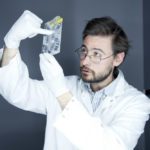Link to Pubmed [PMID] – 21544581
Hum. Genet. 2011 Aug;130(2):255-64
X-inactivation, the molecular mechanism enabling dosage compensation in mammals, is tightly controlled during mouse early embryogenesis. In the morula, X-inactivation is imprinted with exclusive silencing of the paternally inherited X-chromosome. In contrast, in the post-implantation epiblast, X-inactivation affects randomly either the paternal or the maternal X-chromosome. The transition from imprinted to random X-inactivation takes place in the inner cell mass (ICM) of the blastocyst from which embryonic stem (ES) cells are derived. The trigger of X-inactivation, Xist, is specifically downregulated in the pluripotent cells of the ICM, thereby ensuring the reactivation of the inactive paternal X-chromosome and the transient presence of two active X-chromosomes. Moreover, Tsix, a critical cis-repressor of Xist, is upregulated in the ICM and in ES cells where it imposes a particular chromatin state at the Xist promoter that ensures the establishment of random X-inactivation upon differentiation. Recently, we have shown that key transcription factors supporting pluripotency directly repress Xist and activate Tsix and thus couple Xist/Tsix control to pluripotency. In this manuscript, we report that Rnf12, a third X-linked gene critical for the regulation of X-inactivation, is under the control of Nanog, Oct4 and Sox2, the three factors lying at the heart of the pluripotency network. We conclude that in mouse ES cells the pluripotency-associated machinery exerts an exhaustive control of X-inactivation by taking over the regulation of all three major regulators of X-inactivation: Xist, Tsix, and Rnf12.
